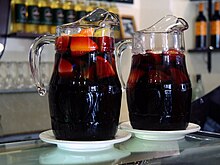Sangria

Sangria is a wine punch typical of Spain and Portugal. It normally consists of:
- a light, dry, young, acidic, unoaked, inexpensive red wine; other reds that work well include French wines such as Gamay or Beaujolais, and Italian wines such as Grignolino, Bardolino, Dolcetto, Freisa, or Lambrusco.
- chopped or sliced fruit (often orange, lemon, apple, peach, berries, pineapple; occasionally melon, grape, or mango)
- a sweetener such as honey, sugar, simple syrup, orange juice, and/or fruit nectar
- a small amount of added brandy, triple sec, or other spirits
- some spices like cinnamon
- and ice and carbonated soda, in some recipes.
Variations
Because of the variation in recipes, sangria's alcoholic content can vary greatly. The ingredients in sangria vary, particularly in the type of fruit used, the kind of spirits added (if any), and the presence or lack of carbonation.
- White wine can be used instead of red, in which case the result is called sangria blanca or, as in Argentina, clerico. An affordable bottle of unoaked, fruit forward Chardonnay would work well here. Some recipes that use heavier reds can be lightened by mixing a bottle of white in the mix. In some parts of Northern Spain, sangria is called zurra and is made with peaches or nectarines [1]. In most recipes, wine is the dominant ingredient and acts as a base. In some regions of Portugal, cinnamon is also added with the sweetener.
- Mulled wine can be used to provide a rich full-bodied taste, chilled with orange juice, lemonade and a sliced pear to add sweetness.
- Preparation consists of cutting the fruit in thin slices or small cubes, then mixing in advance all ingredients except for ice and carbonated sodas. After several hours, or a full day in a refrigerator to allow time for the fruit flavors to blend with the rest of the ingredients, the ice and any last-minute ingredients are added and the drinks are poured.
- A non-alcoholic version of sangria is made from wine grapes, carbonated water, essence of lemon, and cane sugar.
- Sangaree (drink) is a similar drink associated with the West Indies and the name sangaree is an archaic English name for sangria itself.[1]
Serving
Sangria is served throughout Spain and Portugal during summer, and in the southern and eastern parts of the countries year-round. In these places it is a popular drink among tourists at bars, pubs and restaurants where it is often served in 1-litre pitchers or other containers large enough to hold a bottle of wine plus the added ingredients. A lid or other strainer for the container helps prevent the fruit and ice cubes from falling into the glass. Among the Spanish, sangria is most typically served at informal social gatherings, much like punch, from a punchbowl. Sangria is often served with a wooden spoon, used to get fruit out of the bottom of the punchbowl or pitcher. Sangria is also commonly served in Mexico, Chile and Argentina, and at Mexican and Argentine restaurants.
Bottled sangria can be bought in some countries, but this is considered by some to be less entertaining than making it oneself. In the parlance of EU administrators, such products are referred to as "aromatised wines". Sangria has become popular in the UK, with several supermarkets stocking it during summer months.
See also
Notes
- ^ John Ayto. The Glutton's Glossary: A Dictionary of Food and Drink Terms. Routledge, 1990. p. 259.
External links
- Recipe for Sangria in Tertulia Andaluza
- Easy Sangria Recipe Recipe for Spanish Sangria from spanishfood.about.com
- Sangria Recipes 13 Sangria Recipes
- Simple Sangria Recipe by bartender Jeffrey Morgenthaler
